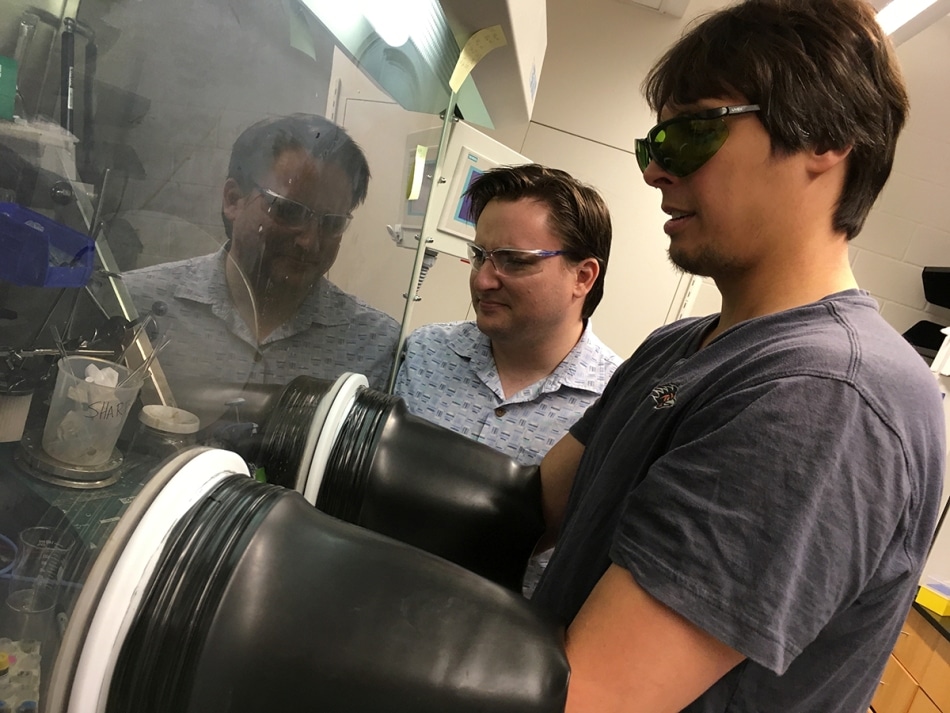Jul 19 2017
A new role for nitric oxide that could send biochemical textbooks back for revision has been discovered by Cornell Chemists.
 Jonathan Caranto, front, and Kyle Lancaster explain their work as they have identified a key step in the nitrification process. Credit: Blaine Friedlander/Cornell Chronicle
Jonathan Caranto, front, and Kyle Lancaster explain their work as they have identified a key step in the nitrification process. Credit: Blaine Friedlander/Cornell Chronicle
They have found a vital step in the nitrification process, which is partially responsible for agricultural emissions of dangerous nitrous oxide and its chemical cousins into the atmosphere, causing global climate change.
Present biochemical models hold the view that inorganic hydroxylamine is the only intermediary produced when bacteria convert ammonia, which is used in commercial agricultural fertilizer, into dormant nitrite. In this study, the Chemists discovered the presence of another intermediary. They found that hydroxylamine is converted into nitric oxide, which acts as the chemical prelude to nitrite under normal soil conditions. However, nitric oxide is converted into the potent greenhouse gas nitrous oxide under imperfect soil conditions. These findings were published in the Proceedings of the National Academy of Sciences, July 17th.
We’ve found a hole in the nitrogen cycle pipeline. As there is nitrous oxide escaping out of the soil into the atmosphere, we now know where the holes are. Nitrous oxide is made from nitric oxide – that’s the immediate precursor. If you know where the nitric oxide is coming from, you can make a good guess about nitrous oxide being released.
Jonathan Caranto, Co-Author and Postdoctoral Researcher in chemistry
The key to finding greenhouse gas solutions lies in the understanding of the model’s working principle. “This is what the research affords: locating new holes to plug. The holes in the pipeline can be sealed. If you don’t fully understand the biochemical pathway, you can’t know where the pollutants come from,” said Co-Author Kyle Lancaster, Assistant Professor of Chemistry, “Otherwise, you are shooting in the dark.”
According to the U.S. Environmental Protection Agency, in 2015, carbon dioxide comprised 82% atmospheric greenhouse gas emissions while nitrous oxide comprised about 5%. However, nitrous oxide is an ozone-depleting gas with a global warming potential that is more than 300 times greater than carbon dioxide, said Caranto. Nitric oxide also causes acid rain and contributes to ground-level ozone.
In the field of medicine, nitric oxide plays a major role. In 1992, it was named as The Molecule of the Year by the journal Science for its versatility in heart health. Scientist Robert F. Furchgott, who earlier worked at Cornell Medical College – now Weill Cornell Medicine – from 1941 to 1949, received the 1998 Nobel Prize in Medicine or Physiology for his role in our understanding of nitric oxide.
The new study shows nitric oxide is produced on the pathway from hydroxylamine to nitrite when soil bacteria use ammonia as chemical fuel. Earlier, Scientists maintained that hydroxylamine is directly converted into nitrite.
This research could make a huge difference in rearranging predictive nitrogen flux models that scientists use to optimize fertilization practices.
Kyle Lancaster, Assistant Professor of Chemistry
Kyle said that the byproducts of commercial fertilization are nitrite production and greenhouse gas, and the processes that form them reduce the efficiency of fertilization. “If you can slow down the formation of these species, slow down the oxidation of ammonia in fertilizer, this will raise the ‘dwell time’ of nitrogen in soil. Agriculture becomes more efficient, more economical and more sustainable.”
A clear understanding of this nitric oxide component could help reduce the cost-to-benefit ratio for Farmers and other Agricultural Producers.
This new component to models could lead to better fertilization scheduling.
Kyle Lancaster, Assistant Professor of Chemistry
The paper, “Nitric Oxide is an Obligate Bacterial Nitrification Intermediate Produced by Hydroxylamine Oxidoreductase,” was supported by an Early Career Award from the U.S. Department of Energy’s Office of Science.